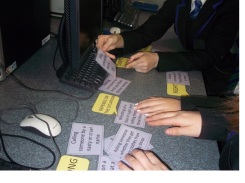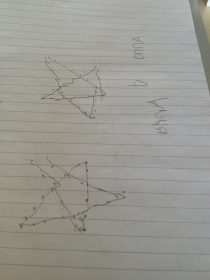Rivers, I. & Duncan, N., (2013). (Eds.) Bullying: Experiences and discourses of sexuality and gender. Oxford: Routledge.
pp. 192, £24.99 (paperback)
The children in the photo’ above are trying to decide whether telling someone that their new coat is gay is okay or not. Often I find that opinions on this vignette divide a class of 13 year-olds. Some children don’t see any problem with this; others think it is always unacceptable. Why is this? Where do these opinions come from?
The use of language surrounding homophobia and norms of masculinity are just two of the issues covered in Bullying: Experiences and discourses of sexuality and gender. Key questions for researchers looking at the gender- and sexuality-based bullying in schools include why this kind of bullying happens and how anti-bullying interventions may help to address this issue. The editors have pulled together a wealth of evidence to speak to these questions, and the result is a state-of-the-art account of the relevant research.
 The editors and authors cover the nature and effects of bullying and cyberbullying in general terms, from individual level analyses that focus on the pathology of bullies and victims, to ‘collective’ explanations that take into account the role of the peer group (giving me my first in-book citation for a research paper in the process 🙂 ). They also consider specific issues faced by LGBT+ (and heteronormative) youth: using information about sexual preferences to hurt others online, sexting and sexual bullying, the race for social dominance in girls’ friendship groups, LGBT+ issues in sport, and stereotypes concerning disability and (lack of) sexual identity. Importantly, the editors also include chapters on how gender- and sexuality-related bullying may be addressed through Gay-Straight Alliances, teacher training, and carefully planned interventions.
The editors and authors cover the nature and effects of bullying and cyberbullying in general terms, from individual level analyses that focus on the pathology of bullies and victims, to ‘collective’ explanations that take into account the role of the peer group (giving me my first in-book citation for a research paper in the process 🙂 ). They also consider specific issues faced by LGBT+ (and heteronormative) youth: using information about sexual preferences to hurt others online, sexting and sexual bullying, the race for social dominance in girls’ friendship groups, LGBT+ issues in sport, and stereotypes concerning disability and (lack of) sexual identity. Importantly, the editors also include chapters on how gender- and sexuality-related bullying may be addressed through Gay-Straight Alliances, teacher training, and carefully planned interventions.
Notable is the wide range of research methods covered. While Helen Cowie’s findings are the result of longitudinal research, Paul Poteat uses established scales to measure homophobic bullying, Schneider reports interview data, and Eric Anderson presents a personal (perhaps auto-ethnographic) account of homophobic attitudes in sport. The work is also multi-disciplinary, with input from those working in Psychology and Education, and accessible to those working in these and related fields.
As the editors acknowledge, several questions remain. There is an increasing amount of research on the L and G in LGBT+, yet not so much on the rest of that picture – do the issues surrounding homophobia and sexual violence also concern transphobia in the same way? What are the optimal resources and school settings for genuine inclusion? I would also argue that there is more work to be done theoretically: why is it that gender and sexuality-based bullying in schools is so norm-dependent, and that peers have such influence in this arena….?
Nonetheless, the central message of the book is positive: perceptions of LGBT+ identities are changing and malleable, and research is bringing us closer to a position where we can effectively confront, and ultimately reduce, the level of sexuality- and gender-based bullying in schools. A recommended read.








